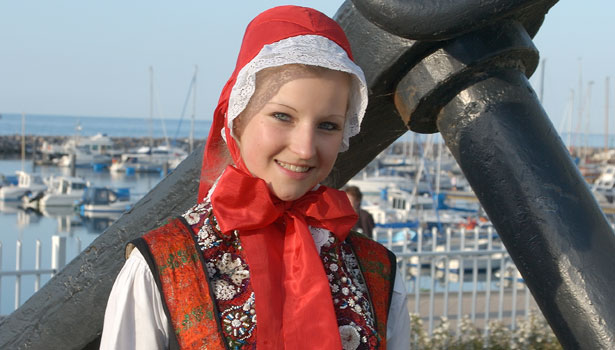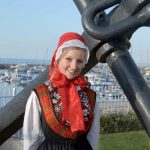Mecklenburger Bauerntracht aus dem 19. Jahrhundert
Kühlungsborn, 04. Juni 2007
Auf der Strandpromenade vor dem Ostsee-Grenzturm und beim Strandresidenz-Stockanker zeigt Paula eine Mecklenburger Bauerntracht aus dem 19. Jahrhundert.
Die Familie der Strandresidenz Kühlungsborn zeigt ihre empfindliche Tracht zum zweiten Mal seit 50 Jahren
Paula (17) trägt auf der Strandpromenade vor dem Ostsee-Grenzturm und beim Strandresidenz-Stockanker eine der mecklenburgischen Bauerntrachten, wie sie im 19. Jahrhundert im Bereich der Klosterstadt Rehna getragen wurden. Es ist möglich, dass die Tracht aus dem Bereich des Kirchspiels Lübsee (Landkreis Nordwestmecklenburg) stammt. Die Familie der Strandresidenz-Kühlungsborn hat dieses historische Kleid seit 50 Jahren im Familienbesitz und zeigt es zum G8-Gipfel erst zum zweiten Mal öffentlich. Zuvor wurde diese Mädchentracht nur um 1979 auf den Mecklenburger Heimattagen in Ratzeburg öffentlich getragen. Die ganze andere Zeit waren alle Trachtenteile mit Mottenschutz und lichtgeschützt verpackt.
Große Teile der Tracht sind noch original. Hervorgehoben werden muss die kostbare Stickerei des Brusttuches. Sie wurde nicht von Berufsstickerinnen gearbeitet, sondern von den Trägerinnen selbst nach freiem Entwurf gestaltet. Auch die Materialien der nachgearbeiteten Trachtenteile wie die der Pie (Rock und Mieder in einem Stück) oder der Haube entsprechen denen der Originale. Sie sind auch schon etwa 70 bis 80 Jahre alt und genauso empfindlich wie die sehr alten Teile, die es auf ein Alter von etwa 150 Jahre bringen. Alle Teile der Tracht sind aus Wolle, Leinen, Seide und Baumwolle (Strümpfe) gearbeitet, also aus Naturfasern. Diese sind inzwischen hochempfindlich und dürfen nur in Ausnahmefällen dem Tageslicht und der Sonne ausgesetzt werden.
Heidemarie Frimodig (66) vom Volkskundemuseum in Schönberg/Meckl. und Rita Völzer (67) vom „Plattdütschen Verein to Rehna“ haben alle Teile der Tracht begutachtet und Paula beim richtigen Anlegen der Tracht beraten. Das korrekte Anziehen und Tragen einer so empfindlichen Original-Tracht muss gelernt sein. Da die Originalhaube schon in einem desolaten Zustand ist und nicht mehr getragen werden kann, hat Rita Völzer dankenswerterweise Paula ihre Rehnaer Mädchenhaube (Stierthüll‘) aus roter Seide zur Verfügung gestellt. Die Frauenhauben sind schwarz.
Historiker berichten übereinstimmend, dass alte Leute ihnen oft das glanzvolle Bild geschildert haben, welches früher die Gotteshäuser an Sonn- und Festtagen boten. Ein früherer Augenzeuge berichtete, dass er als Knabe 1877 vom Chor der Rehnaer Kirche 112 Bauernfrauen und -töchter in solch einem Gewand gezählt habe. Den Rehnaer „Stiertmützen“, so genannt wegen der langen, über den Rücken hängenden Bänder, konnte man noch bis zum 1. Weltkrieg häufig begegnen. Die letzte ständige Trachtenträgerin starb in den 30er Jahren des vergangenen Jahrhunderts.
Die wirklich alten Trachten sind heute in den Museen oder werden noch in Privatbesitz als kostbarer Schatz gehütet. In den Heimatvereinen findet man mehr oder minder sorgfältig nachgearbeitetes „Buerntüg“. Die Akribie mit der die Rehnaer Tracht im „Plattdütschen Verein to Rehna“ nachgearbeitet wurde und wird, ist kaum zu überbieten. Dort wird noch mit der Hand genäht und gestickt.
Die von Paula getragene „Rhe(e)insche Dracht“ wird in Kürze wieder gesäubert und mottensicher lichtgeschützt verpackt, um auch den nächsten Generationen der Familie erhalten zu bleiben.
Ostsee-Grenzturm:
www.ostsee-grenzturm.com
Strandresidenz Kühlungsborn:
www.strandresidenz.info
Volkskundemuseum Schönberg:
www.ratzeburger-land.de






